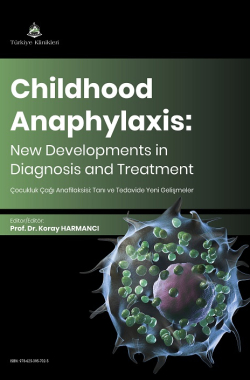ANAPHYLAXIS WITH BIOLOGICALS
Işıl Eser Şimşek
Kocaeli University, Faculty of Medicine, Department of Pediatric Immunology and Allergic Diseases, Kocaeli, Türkiye
Eser Şimşek I. Anaphylaxis with Biologicals. In: Harmancı K, editor. Childhood Anaphylaxis: New Developments in Diagnosis and Treatment. 1st ed. Ankara: Türkiye Klinikleri; 2025. p.149-156.
ABSTRACT
Biologic drugs (BDs) are a diverse category of biotherapeutic product that include monoclonal antibodies (mAb), fusion proteins,cytokines, hormones and vaccines. Dramatically increasing use of BDs has led to an increase in the anaphylaxis to these drugs. Recently, in the classification based on phenotype, endotype and biomarkers, the mechanisms responsible for anaphylactic reactions caused by these drugs have been shown as Type 1 (IgE/Non IgE), cytokine release reactions (CSR) and their combination (mixed reactions). While type I reactions typically occur after at least one previous administration, CRRs may occur at first the first known administration and usually quickly disappear with repeated exposures. Apart from the clinical story, if available, performing skin tests (ST) such as prick test and intradermal test (IDT), in vitro assays and drug provocations will assist the allergists to identifying the underlying mechanism the reaction. The skin test positivity and increased tryptase level will help to distinguish Type I reactions from the CRRs, while IL-6 elevation is most closely associated with CRRs. Rapid drug desensitization (RDD) should be performed in the patient with positive ST to BD, regardless of the grade of the reaction. If the reaction is mild and skin test result is negative, it is recommended to administer the culprit BD by drug provocation test (DPT). If the DPT is positive, the patient should receive the responsible drug with RDD; whereas if the DPT is negative, the patient can switch to regular infusions.
Keywords: Biological drugs; Anaphylaxis; Drug hypersensitivity; Cytokine release syndrome
Kaynak Göster
Referanslar
- Mori F, Saretta F, Bianchi A, Crisafulli G, Caimmi S, Liotti L et al. Hypersensitivity Reactions to Monoclonal Antibodies in Children. Medicina (Kaunas). 2020 May 12;56(5):232. [Crossref] [PubMed] [PMC]
- Bavbek S, Pagani M, Alvarez-Cuesta E, Castells M, Dursun AB, Hamadi S. Et al. Hypersensitivity reactions to biologicals: An EAACI position paper. Allergy. 2022;77(1):39-54. [Crossref] [PubMed]
- World Health Organization. Expert committee on biological standardization. World Health Organ Tech Rep Ser. 2014:(980):1-489.
- Ozdemiral C, Soyer Ö. Hypersensitivity reactions to biologic drugs in children with rheumatologic disease. In: Başaran HÖ, ed. Overview of Biologic Agents in Pediatric Rheumatology. 1st ed. Ankara: Türkiye Klinikleri; 2024:55-62.
- Yang BC, Castells M. Medical algorithm: Diagnosis and treatment of drug hypersensitivity reactions to biologicals, 2024 update. 2024 Oct 14. [Crossref] [PubMed]
- Matucci A, Vultaggio A, Nencini F, Maggi E. Anaphylactic reactions to biological drugs. Curr Opin Allergy Clin Immunol. 2020;20:346-351. [Crossref] [PubMed]
- Timothy G. Chow, MDa, John Oppenheimer, MDb,c, and Shyam R. Joshi, MD. A Review of Adverse Reactions to Biologics Used in Allergy-Immunology Practice. J Allergy Clin Immunol Pract. 2022;10:3075-86. [Crossref] [PubMed]
- Muraro A, Lemanske RFJ, Castells M, Torres MJ, Khan D, Simon H-U, et al. Precision medicine in allergic disease-food allergy, drug allergy, and anaphylaxisPRACTALL document of the European Academy of Allergy and Clinical Immunology and the American Academy of Allergy, Asthma and Immunology. Allergy. 2017;72:1006-21. [Crossref] [PubMed]
- Çelik GE, Pichler WJ, Adkinson NF. Drug Allergy. In Middleton's Allergy Principles and Practice. Eds. Adkinson NF, Bochner BS, Wesley Burks A, Busse WW, Holgate ST, Lemanske RF, O'Hehir ER. Elsevier Saunders. 8th edition 2014:1274-1295. [Crossref]
- Baert F, Noman M, vermeire S, van Assche G, D' Haens G, Carbonez A, et al. Influence of immunogenicity on the long-term efficacy of infliximab in Crohn's disease. N Engl J Med. 2003;348(7):601-8. [Crossref] [PubMed]
- Brown SG. Clinical features and severity grading of anaphylaxis. J Allergy Clin Immunol. 2004;114(2):371-6. [Crossref] [PubMed]
- Wheatley LM, Plaut M, Schwaninger J.M, Banerji A, Castells M, Finkelman FD et al. Report from the National Institute of Allergy and Infectious Diseases workshop on drug Eser Şimşek Anaphylaxis with Biologicals allergy. J Allergy Clin Immunol. 2015;136:262-71. [Crossref] [PubMed] [PMC]
- Isabwe GAC, Garcia Neuer M, de Las Vecillas Sanchez L, Lynch DM, Marquis K, et al. Hypersensitivity reactions to therapeutic monoclonal antibodies: phenotypes and endotypes. J Allergy Clin Immunol. 2018;142:159. 70.e2. [Crossref] [PubMed]
- Akarsu A, Soyer O, Sekerel BE. Hypersensitivity Reactions to Biologicals: from Bench to Bedside. Curr Treat Options Allergy. 2020;7(1):71-83. [Crossref] [PubMed] [PMC]
- Brennan PJ, Rodriguez Bouza T,Hsu FI, Sloane DE, Castells MC. Hypersensitivity reactions to mAbs: 105 desensitizations in 23 patients, from evaluation to treatment. J Allergy Clin Immunol. 2009;124:1259-66. [Crossref] [PubMed]
- Muraro A, Worm M, Alviani C, Cardona V, DunnGalvin A, Garvey LH, et al. European Academy of Allergy and Clinical Immunology, Food Allergy, Anaphylaxis Guidelines Group. EAACI guidelines: Anaphylaxis (2021 update). Allergy. 2022;77(2):357-77. [Crossref] [PubMed]
- Vázquez-Revuelta P, Martí-Garrido J, Molina-Mata K, LleonartBellfill R, Rey-Salido M, Madrigal-Burgaleta R. Delabeling patients from chemotherapy and biologics allergy: Implementing drug provocation testing. J Allergy Clin Immunol: In Practice. 2021;9(4):1742-1745. [Crossref] [PubMed]
- Martí-Garrido J, Vázquez-Revuelta P, Lleonart-Bellfill R, MolinaMata K, Muñoz-Sánchez C, Madrigal-Burgaleta R. Pilot experience using drug provocation testing for the study of hypersensitivity to chemotherapy and biological agents. J Investig Allergol Clin Immunol. 2021;31(2):166-168. [Crossref] [PubMed]

